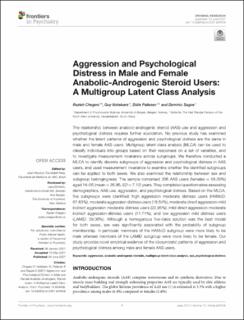| dc.contributor.author | Chegeni, Razieh | |
| dc.contributor.author | Notelaers, Guy Louis Alice | |
| dc.contributor.author | Pallesen, Ståle | |
| dc.contributor.author | Sagoe, Dominic | |
| dc.date.accessioned | 2021-08-13T08:57:45Z | |
| dc.date.available | 2021-08-13T08:57:45Z | |
| dc.date.created | 2021-06-27T12:57:30Z | |
| dc.date.issued | 2021 | |
| dc.identifier.issn | 1664-0640 | |
| dc.identifier.uri | https://hdl.handle.net/11250/2767730 | |
| dc.description.abstract | The relationship between anabolic-androgenic steroid (AAS) use and aggression and psychological distress requires further elucidation. No previous study has examined whether the latent patterns of aggression and psychological distress are the same in male and female AAS users. Multigroup latent class analysis (MLCA) can be used to classify individuals into groups based on their responses on a set of variables, and to investigate measurement invariance across subgroups. We therefore conducted a MLCA to identify discrete subgroups of aggression and psychological distress in AAS users, and used measurement invariance to examine whether the identified subgroups can be applied to both sexes. We also examined the relationship between sex and subgroup belongingness. The sample comprised 206 AAS users (females = 58.30%) aged 14–56 (mean = 26.86, SD = 7.12) years. They completed questionnaires assessing demographics, AAS use, aggression, and psychological distress. Based on the MLCA, five subgroups were identified: high aggression moderate distress users (HAMoD: 07.63%), moderate aggression distress users (18.64%), moderate direct aggression-mild indirect aggression moderate distress users (22.95%), mild direct aggression-moderate indirect aggression-distress users (11.71%), and low aggression mild distress users (LAMiD: 39.06%). Although a homogenous five-class solution was the best model for both sexes, sex was significantly associated with the probability of subgroup membership. In particular, members of the HAMoD subgroup were more likely to be male whereas members of the LAMiD subgroup were more likely to be female. Our study provides novel empirical evidence of the idiosyncratic patterns of aggression and psychological distress among male and female AAS users. | en_US |
| dc.language.iso | eng | en_US |
| dc.publisher | Frontiers Media | en_US |
| dc.rights | Navngivelse 4.0 Internasjonal | * |
| dc.rights.uri | http://creativecommons.org/licenses/by/4.0/deed.no | * |
| dc.title | Aggression and Psychological Distress in Male and Female Anabolic-Androgenic Steroid Users: A Multigroup Latent Class Analysis | en_US |
| dc.type | Journal article | en_US |
| dc.type | Peer reviewed | en_US |
| dc.description.version | publishedVersion | en_US |
| dc.rights.holder | Copyright 2021 Chegeni, Notelaers, Pallesen and Sagoe | en_US |
| dc.source.articlenumber | 629428 | en_US |
| cristin.ispublished | true | |
| cristin.fulltext | original | |
| cristin.qualitycode | 1 | |
| dc.identifier.doi | 10.3389/fpsyt.2021.629428 | |
| dc.identifier.cristin | 1918725 | |
| dc.source.journal | Frontiers in Psychiatry | en_US |
| dc.identifier.citation | Frontiers in Psychiatry. 2021, 12, 629428. | en_US |
| dc.source.volume | 12 | en_US |

